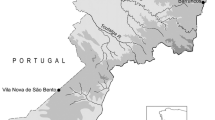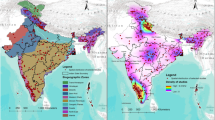Abstract
Rapid acceleration of industrial development in north-eastern British Columbia is currently occurring without a comprehensive assessment of the effects it will have on ecological or cultural systems. The cumulative effects of past development are already being felt within the Treaty 8 First Nations of the region but these effects have not been quantified from a landscape point of view. Using habitat modeling and GIS analysis the effects of 35 years of agricultural and industrial development on forest biodiversity and ecological integrity were investigated for a 410,000 ha landscape in north-eastern British Columbia. The study identified a significant increase in area impacted by developments which lead to a shift in landscape structure and significant change in forest biodiversity. Forest fragmentation and habitat loss has resulted in an increase in open, early seral and edge habitats at the expense of contiguous mature forests. The change in landscape structure resulted in a significant increase in species richness as generalist and early seral species responded positively to increases in these habitats. A significant increase in brown-headed cowbird parasitism risk was also detected. Changes in landscape structure, reduction in habitat for 22% of modeled species, increase parasitism and predation risk due to fragmentation, and increased access have resulted in a cumulative effect of recent resource development on ecological integrity that is both additive and synergistic. The propose acceleration of future development will increase the risk to maintaining the biodiversity and ecological integrity in the Peace-Moberly region of British Columbia.










Similar content being viewed by others
References
Ahlén I (1975) Winter habitats of moose and deer in relation to land use in Scandinavia. Swed Wildl 9:45–192
Angermeier PL, Karr JR (1994) Biological integrity versus biological diversity as policy directives: protecting biotic resources. Bioscience 44:690–687
B.C. Conservation Data Centre (2006) BC species at ecosystems explorer. B.C. Ministry of Environment. Victoria, BC. Available from http://srmapps.gov.bc.ca/apps/eswp/ (Accessed January 2007)
Bender DJ, Contreras TA, Fahrig L (1998) Habitat loss and population decline: a meta-analysis of the patch size effect. Ecology 70:517–533
Benkman CW (1993) Logging, conifers, and the conservation of crossbills. Conserv Biol 7:473–479
Bennett AF (1990) Land use, forest fragmentation and the mammalian fauna at Naringal, south-western Victoria. Aust Wildl Res 17:325–347
Buskirk SW, Zielinski WJ (2003) Small and mid-sized carnivores. In: Zabel CJ, Athony RG (eds) Mammal community dynamics: management and conservation in the coniferous forests of Western North America. Cambridge University Press, Cambridge, UK, pp 207–249
Campbell RW, Smith GEJ, McNall MCE et al (1997) The birds of British Columbia, Volume 3: Passerines – Flycatchers through Vireos. UBC Press, Vancouver
Campbell RW, Dawe NK, McTaggert-Cowan I et al (2001) The birds of British Columbia, Volume 4: Wood warblers through Old World Sparrows. UBC Press, Vancouver
Canadian Intermountain Joint Venture (2003) Biological foundation and prospectus. British Columbia, Canada
Chadwick JW, Canton SP (1984) Inadequacy of diversity indices in discerning metal mine drainage effects on a stream invertebrate community. Water Air Soil Pollut 22:217–223
Dale VH, Beyeler SC (2001) Challenges in the development and use of ecological indicators. Ecol Indicators 1:3–10
Davis LS, Johnson KN, Bettinger PS et al (2001) Forest management: to sustain ecological, economic, and social values, 4th edn. Waveland Press, Long Grove, IL
Didman RK, Lawton JH (1999) Edge structure determines the magnitude of changes in microclimate and vegetation structure in tropical forest fragments. Biotropica 31:17–30
Dixon J, Montz BE (1995) From concept to practice: implementing cumulative impact assessment in New Zealand. Environ Manage 19:445–456
Doak DF (1995) Source-sink models and the problem of habitat degradation: general models and applications to the Yellowstone grizzly. Conserv Biol 9:1370–1379
Donovan TM, Thompson FR, Faaborg J et al (1995) Reproductive success of migratory birds in habitat sources and sinks. Conserv Biol 9:1380–1395
Donovan TM, Jones PW, Annand EM et al (1997) Variation in local-scale edge effects: mechanisms and landscape context. Ecology 78:2064–2075
Drapeau P, Leduc A, Giroux J-F et al (2000) Landscape-scale disturbances and changes in bird communities of the Boreal mix-wood forests. Ecol Monogr 70:423–444
Dyer SJ, O’Neill JP, Wasel SM et al (2001) Avoidance of industrial development by woodland caribou. J Wildl Manage 65:531–542
Edenius L, Sjöberg K (1997) Distribution of birds in natural landscape mosaics of old-growth forests in northern Sweden: relations to habitat area and landscape context. Ecography 20:425–431
Environmental Systems Research Institute (2006) ESRI ArcGIS 9.2, Environmental Systems Research Institute Ltd., USA
Fiori SM, Zalba SM (2003) Potential impacts of petroleum exploration and exploitation on biodiversity in a Patagonian nature reserve, Argentina. Biodivers Conserv 12:1261–1270
Flannery TF (1994) The future eaters. Reed New Holland, Australia
Flaspohler DJ, Temple SA, Rosenfield RN (2001) Species-specific edge effects on nest success and breeding bird density in a forested landscape. Ecol Appl 11:32–46
Gergel SE (2002) Assessing cumulative impacts of levees and dams on floodplain ponds: a neutral-terrain model approach. Ecol Appl 12:1740–1754
Gomez DM, Anthony RG (1996) Amphibian and reptile abundance in riparian and upslope areas of five forest types in western Oregon. Northwest Sci 70:109–119
Gotelli NJ, Ellison AM (2004) A primer of ecological statistics. Sinauer Associates, Inc. Sunderland, MA
Hansen AJ, Neilson RP, Dale VH et al (2001) Global change in forests: responses of species, communities and biomes. Bioscience 51:765–779
Hanski IK, Fenske TJ, Niemi GJ (1996) Lack of edge effect in nesting success of breeding birds in managed forest landscapes. Auk 113:578–585
Hansson L (1994) Vertebrate distributions relative to clear-cut edges in the boreal forest landscape. Landsc Ecol 9:105–115
Harris LD (1988) Edge effects and conservation of biotic diversity. Conserv Biol 2:330–332
James ARC, Stuart-Smith AK (2000) Distribution of caribou and wolves in relation to linear corridors. J Wildl Manage 64:154–159
Kimmins JP (2004) Forest ecology: a foundation for sustainable forest management and environmental ethics in forestry, 3rd edn. Prentice Hall, Upper Saddle River, NJ
Kroodsma RL (1984) Effect of edge on breeding forest bird species. Wilson Bull 96:426–436
Laurance WF, Lovejoy TE, Vasconcelos HJ et al (2002) Ecosystem decay of Amazonian forest fragments: a 22 year investigation. Conserv Biol 16:605–618
Lindenmayer DB (1999) Future directions for biodiversity conservation in managed forests: indicator species, impact studies and monitoring programs. For Ecol Manage 115:277–287
Lindenmayer DB, Franklin JF (2002) Conserving forest biodiversity: a comprehensive multiscaled approach. Island Press, Washington, DC
Lloyd P, Martin TE, Redmond RL et al (2005) Linking demographic effects of habitat fragmentation across landscapes to continental source-sink dynamics. Ecol Appl 15:1504–1514
MacDonald LH (2000) Evaluating and managing cumulative effects: processes and constraints. Environ Manage 26:299–315
Margalef DR (1958) Information theory in ecology. Gen Syst 3:36–71
McComb WC, Anthony RG, Newton M (1993) Small mammal and amphibian abundance in streamside and upslope habitats of mature Douglas-fir stands, western Oregon. Northwest Sci 76:7–15
McGarigal K, Romme WH, Crist M et al (2001) Cumulative effects of roads and logging on landscape structure in the San Juan Mountains, Colorado (USA). Landsc Ecol 16:327–349
Meidinger D, Pojar J (1991) Ecosystems of British Columbia. B.C. Ministry of Forests, Victoria, BC
Mesquita R, Delamônica P, Laurance WF (1999) Effects of surrounding vegetation on edge-related tree mortality in Amazonian forest fragments. Biol Conserv 91:129–134
Miller JR, Joyce LA, Knight RL et al (1996) Forest roads and landscape structure in the southern Rocky Mountains. Landsc Ecol 11:115–127
Niemela J, Langor D, Spence JR (1993) Effects of clear-cut harvesting on boreal ground-beetle assemblages (Coleoptera: Carabidae) in western Canada. Conserv Biol 7:551–561
O'Neil TA, Johnson DH, Barrett C et al (2001) Matrixes for wildlife-habitat relationships. In: Johnson DH, O’Neil TA (eds) Wildlife – habitat relationships in Oregon and Washington. Oregon State University Press, Corvallis
Partners in Flight British Columbia and Yukon (2007) Plans and implementation. Partners in Flight British Columbia and Yukon. Available from www.pifbcyukon.org (Accessed January 2007)
Pearson K (1900) Mathematical contribution to the theory of evolution VII: on the correlation of characters not quantitatively measurable. Philos Trans R Soc Ser A 195:1–47
Peele JM, Ulrich DL, Mackie JL (1976) Moose habitat selection and relationships to forest management in Northeastern, Minnesota. Wildl Monogr 48:1–65
Poore D (2003) Changing landscapes. International Tropical Timber Organisation and Earthscan Publications Ltd., London
Reed RA, Johnson-Barnard J, Baker WL (1996) Fragmentation of a forested Rocky Mountain Landscape, 1950–1993. Biol Conserv 75:267–277
Roloff GJ, Wilhere F, Quinn T et al (2001) An overview of models and their role in wildlife management. In: Johnson DH, O’Neil TA (eds) Wildlife–habitat relationships in Oregon and Washington. Oregon State University Press, Corvallis
Sala OE, Chapin FS, Armesto J et al (2000) Global Biodiversity Scenarios for the Year 2100. Science 287:1770–1774
Schneider RR, Stelfox JB, Boutin S et al (2003) Managing the cumulative impacts of land uses in the Western Canadian Sedimentary Basin: a modeling approach. Conserv Ecol 7:8
Sokal RR, Rohlf FJ (1995) Biometry: the principles and practice of statistics in biological research, 2nd edn. W. H. Freeman, New York
Spaling H, Smit B (1993) Cumulative environmental change: conceptual frameworks, evaluation approaches, and institutional perspectives. Environ Manage 17:587–600
Sullivan TP, Sullivan DS, Lindgren PMF (2001) Stand structure and small mammals in young lodgepole pine forest: 10-year results after thinning. Ecol Appl 11:1151–1173
Tabachnick BG, Fidell LS (2001) Using multivariate statistics, 4th edn. Allyn and Bacon, Boston, MA
The World Conservation Union (2001) IUCN Red List Categories and Criteria: Version 3.1. IUCN Species Survival Commission, Gland, Switzerland
Tinker BB, Resor CAC, Beauvais GP et al (1998) Watershed analysis of forest fragmentation by clearcuts and roads in a Wyoming forest. Landsc Ecol 13:149–165
Trzcinski MK, Fahrig L, Merriam G (1999) Independent effects of forest cover and fragmentation on the distribution of forest breeding birds. Ecol Appl 9:586–593
United States Fish and Wildlife Service (1981) Standards for development of habitat suitability index models. United States Fish and Wildlife Service Division of Ecological Services, ESM 103, Washington, DC
Williams B, Marcot B (1991) Use of biodiversity indicators for analyzing and managing forest landscapes. Trans N Am Wildl Nat Resour Conf 56:613–627
With KA, Crist TO (1995) Critical thresholds in species; responses to landscape structure. Ecology 76:2446–2459
Yahner RH (1988) Change in wildlife communities near edges. Conserv Biol 2:333–339
Acknowledgments
First, and most importantly, I would like to thank the British Columbian Treaty 8 Tribal Council for allowing me to conduct this research on their traditional territory and for providing information paramount to the success of this project. Their support and interests are at the foundation of this project. I would also like to thank the British Columbian government for providing information on forest and oil and gas development. I would also like to acknowledge the leadership and guidance of Dr. John Innes on this project. Finally, I would like to thank the Sustainable Forest Management Network for funding this research project.
Author information
Authors and Affiliations
Corresponding author
Rights and permissions
About this article
Cite this article
Nitschke, C.R. The cumulative effects of resource development on biodiversity and ecological integrity in the Peace-Moberly region of Northeast British Columbia, Canada. Biodivers Conserv 17, 1715–1740 (2008). https://doi.org/10.1007/s10531-008-9376-6
Received:
Accepted:
Published:
Issue Date:
DOI: https://doi.org/10.1007/s10531-008-9376-6




